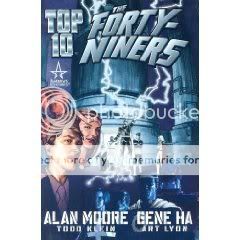Top 10: The Forty-Niners
Alan Moore, writer
Gene Ha, artist
DC/WildStorm/America’s Best Comics, 2005
112 pages, hardcover
$24.99
Originally written on November 18, 2005 for publication by The Comics Journal
This is a nice little comic from Alan Moore. That in itself is remarkable–did you ever think that in this stage in his career Moore would be producing “nice little comics”? In wildly ambitious books like Watchmen and From Hell Moore was the pioneer of the comic-narrative-as-intelligent design, in which meticulously devised plot points move like intricate clockwork toward an inescapable conclusion which consequently reveals to the reader the baroque planning in all that has gone before. (And I’m not even just talking about Moore himself there–the story arcs for his villains Ozymandias and William Gull follow the very same pattern.) And as extraordinarily rich and rewarding as the comics Moore created with that approach have been, it’s nice to see him kick off his shoes and relax a bit. Creating art that’s not quite so ostentatiously inorganic–telling a story rather than creating a parlor game, in other words–can be rewarding too.
That’s not to say that this prequel to Moore’s “Hill Street Blues with superhero cops” dramedy Top 10 is entirely free of the Bearded One’s sometimes too-heavy authorial hand. A sequence in which an unsuccessful sexual coupling is juxtaposed with a brutal and sexualized multiple murder (by vampires, no less) is an almost shockingly facile use of montage for a writer of Moore’s skill and experience. A subplot in which a young former World War II flying ace and his mustachioed German commander fall in love feels less like something two actual people are actually doing and more like Moore saying, “hey, they’re gay, and that’s okay!” Well, of course it is. And? Dopiest of all is a bit in which a partially viewed headline from a newspaper seen via a time machine (“NAZIS RUN USA” reads the obviously incomplete block text) manages to convince several otherwise intelligent characters that a couple of Nazi mad scientists will succeed in their plot to conquer America, despite the fact that an actual newspaper in a Nazi-ruled U.S. would no more need to run such a headline than the New York Times would need to announce to its readers “BILL CLINTON IS PRESIDENT” in mid-1994.
But The Forty-Niners remains fun because of its delightful setting–Neopolis, a city full of superhumans–and structure–like a TV series, it has ongoing interweaving A, B, and C plots, and individual “episodes” alternate between focusing on this or that set of characters. These two wide-open parameters give Moore a lot more room to play than either his ABC line’s more straightforward genre pastiches like Tom Strong or Tomorrow Stories (cute but depthless) or his didactic magickal opus Promethea (wonderful to look at, but I didn’t buy this kind of stuff when it was being fed to me in Catholic school; is it supposed to be easier to swallow from a guy who invented his own snake god?). Moore uses Romanian vampires as an Eastern European mafia, has superhero cops arrest superhero civilians for vigilantism, and creates a female German defector named Sky Witch who rides around on a rocket-powered broom-lookin’ thing. He’s clearly having a good time, but at the same time creating a story that doesn’t depend on contrast with preexisting archetypes or on castles-made-of-sand metaphysics for its oomph.
And he’s helped quite a bit by artist Gene Ha, who skillfully tempers a dynamic naturalism that would be at home in one of Marvel’s Ultimate titles by giving nearly all of his characters slightly overemphasized noses that look like they’ve been blown into cheap tissues about forty times that day and legs that look like they’d comfortably fit on the body of Tommy Tune. They look real, but they look vulnerably cartoonish too. And his designs for Neopolis itself are wondrous–it’s probably the best-realized superhero city since Anton Furst’s Gotham in the first Tim Burton Batman picture. Colorist Art Lyon bathes Ha’s figures in sepia to convey the story’s post-war “pastness”; sure, it’s a little easy, but it’s also a little gorgeous. Kinda like the book itself.
Tags: comics, comics reviews, Comics Time, reviews

